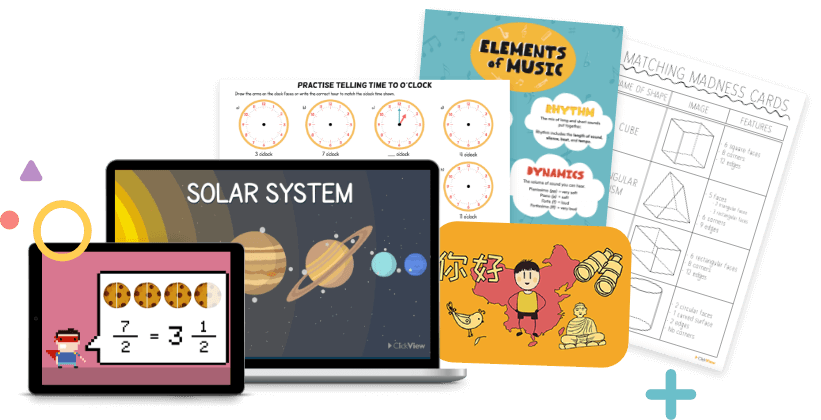Teaching reading: strategies & methods to encourage learning
Various studies show that promoting reading can have a major impact on children and their future. In this article, we’ll look at various strategies and methods to support the teaching of reading and comprehension in early primary school and beyond. There’s more than one way to teach children to read. So, it’s important to have a range of different strategies and methods to encourage learning in different students.
Teaching reading: strategies & methods
- Read aloud to students
- Provide opportunities for students to read, write and talk about texts
- Read texts repeatedly to support fluency
- Teach children the tools to figure out words they don’t know
- Provide time for studying spoken language, including vocabulary and spelling
- Use prior knowledge to make connections
- Predict
- Visualise
- Summarise
- Teach critical thinking skills
The early years: strategies for teaching reading
Literacy teaching and learning are core responsibilities of teachers and schools. Yet teaching reading and writing is a complex and highly skilled professional activity. Many young learners start school with little knowledge about how to read and write. Teachers are tasked with helping children to bridge the significant gap between linking their written and spoken language. Learning to read is critical, with research showing that reading for pleasure can:
- Promote improved health and wellbeing
- Help build social connections and relationships
- Increase the chances of social mobility.
Teaching reading is an evolving and non-linear process that works differently for each young student. The programmes of study for reading at key stages 1 and 2 include word reading and comprehension (both listening and reading). Early primary teachers are tasked with developing competence in both dimensions. Teaching reading will involve teaching letters, sounds and vocabulary, but beyond this, it will also involve strategies such as guided reading and building background knowledge. Learning to read should include exposure to a wide variety of interesting books and different kinds of texts, such as online and interactive app and web content.
Here are 10 strategies to try with young children to support their reading skill development and comprehension.
1. Read aloud to students
This reading aloud will occur in the classroom, supplemented by consistent at-home reading, even once a child learns to read at a basic level. Encourage children to play with sound and listen out for all the different sounds around them, to help them tune in to their new word sounds.
2. Provide opportunities for students to read, write and talk about texts
Regularly giving students time to read, write and talk about texts can enhance their skill development across multiple areas. For instance, reading more can further support writing and vice versa. By talking about texts, and hearing the perspectives of classmates, young children also have the opportunity to deepen their comprehension. Encourage parents to further engage young readers, by helping children when they get stuck and talking with them about what they have read.
3. Read texts repeatedly to support fluency
Students need to hear the same texts multiple times to support their reading fluency. Often, they are naturally drawn to familiar texts, which they learn to grasp with growing complexity and understanding over time.
4. Teach children the tools to figure out words they don’t know
Teaching students to read for the ultimate goal of producing independent readers begins by explicitly teaching the code we use to decode words. That starts with teaching phonemic awareness.
Here are some other strategies that support phonics instruction:
- For beginning readers, target words that are decodable. These are regular spellings with regular sounds. (Ex. such – /s/ /u/ /ch/ not gone)
- Sound out each phoneme and blend as you go by going back to the first sound everytime a sound is added. Hold the sound (sing) then add the next sound. Ex. /g/, /r/, gr—, /ow/, grow.
Note: Students may want to look at pictures for context, but this does not help them decode words. As we encourage students to read more difficult texts, they won’t have pictures to rely on, so encourage them not to use the pictures to decode difficult words.
This might involve combining strategies, such as:
- Sounding out a word using phonics knowledge
- Looking at the pictures
- Skipping the word and coming back to it after reading the rest of the sentence
- Thinking about what would make sense.
Introducing young children to the wonder and enjoyment of books requires a systematic teaching of phonics. As a primary teacher, you can support the families of your young students by sharing phonics resources (because things have changed since they were at school!) Help parents to support student learning accurately, which can lead to better student learning and engagement outcomes.
5. Provide time for studying spoken language, including vocabulary and spelling
A comprehensive approach to teaching reading also includes providing time to develop complementary skills, such as:
- Spoken language, including through conversation or oral presentations
- Vocabulary, such as building class lists while reading texts
- Spelling
- Grammar, such as through bite-sized video content like the Grammar Miniclips series.
6. Use prior knowledge to make connections
Each student brings unique prior knowledge to their reading education. This knowledge is the sum of all experiences and knowledge they bring to the reading or viewing of a text. This could include personal experiences, cultural or religious experiences and concept knowledge. Prior knowledge helps young readers infer meaning from text, a skill that is recognised as a predictor of reading comprehension at various developmental stages and one of the drivers of sophisticated reading ability. An early reader can activate prior knowledge and make connections at each stage.
- Before reading, they could ask ‘What do I already know about this topic?’
- During reading, they could reflect ‘This part of the text is just like…’
- After reading, they could offer ‘I know more about this topic now.’
7. Predict
Prediction is about anticipation and working out the actions and ideas that are coming next. An early reader can use prediction at each stage of reading.
- Before reading, they could suggest ‘From the cover, I think this book will be about…’
- During reading, they could predict which word comes next in a sentence.
- After reading, they could comment on whether their predictions were correct.
8. Visualise
Visualising uses the senses combined with prior knowledge to create a mental picture of what’s being read. Young readers, especially with teacher or parent prompting, can draw on their senses to imagine smells, sounds, tastes and images that go with the story they are reading, like a show or movie in their mind.
9. Summarise
Teaching students to recall the main points or ideas of a story is not easy. First, they need to be able to put the story in order, then put it in their own words before they can articulate a ‘summing up’ of the author’s main ideas. To start to learn to summarise, young students can practise:
- Selecting the key words from a paragraph
- Locating the topic sentence (often found at the start or end of a paragraph)
- Responding to general questions about a story
- Talking through the story in their own words
10. Teach critical thinking skills
Critical thinking gets readers to start thinking about why texts are created in particular ways. You can encourage young readers to ask some of the following questions to get them thinking critically about what they are reading:
- Why did the author write this story?
- What’s been left out of the story?
- How do I feel about this story?

Reading comprehension strategies
Opportunities for teaching reading comprehension occur at all levels throughout the curriculum. The reading strategies discussed earlier in the article should therefore be practised, consolidated and expanded on as a student progresses through school. Good comprehension draws from both linguistic knowledge and knowledge of the world we live in. Students develop skills in comprehension though high-quality discussion with teachers, as well as from regularly reading and discussing a range of texts across genres.
Beyond the early years, reading deepens in complexity to involve literal, interpretive and inferential comprehension, reading on the lines, between the lines and beyond the lines. It involves concepts such as transferring knowledge to new contexts, understanding an author’s viewpoint, purpose and intended audience and critically analysing messages and information in a range of literacy modes for a variety of purposes.
Recommendations for teachers to support the progression of reading comprehension:
- Make sure your students spend significant amounts of time reading engaging texts.
- Select texts for students which support authentic learning. These could include topic-based or interest-based texts.
- Give students access to a range of texts in various genres (multimodal, print-based, images, animations, graphic representations, video, audio, diagrams/charts, newspapers/magazines, fiction, non-fiction).
- Identify and discuss vocabulary from rich texts with your students.
- Give your students time to talk to each other about the texts they have read and listened to.
- Give students time to write and reflect on their reading.
Bring the study of English to life for your students
ClickView offers a huge range of educational videos for use in the secondary English classroom. We regularly produce high-quality, curriculum-aligned videos and add these to the collection.



This is everything I was looking for, thank you.